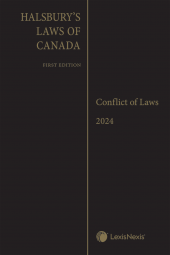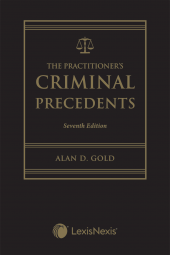Sentencing - Practical Approaches
One Year Subscription Only Terms
Subscribers receive the product(s) listed on the Order Form and any Updates made available during the annual subscription period. Shipping and handling fees are not included in the annual price.
Subscribers are advised of the number of Updates that were made to the particular publication the prior year. The number of Updates may vary due to developments in the law and other publishing issues, but subscribers may use this as a rough estimate of future shipments. Subscribers may call Customer Support at 800-833-9844 for additional information.
Subscribers may cancel this subscription by: calling Customer Support at 800-833-9844; emailing customer.support@lexisnexis.com; or returning the invoice marked 'CANCEL'.
If subscribers cancel within 30 days after the product is ordered or received and return the product at their expense, then they will receive a full credit of the price for the annual subscription.
If subscribers cancel between 31 and 60 days after the invoice date and return the product at their expense, then they will receive a 5/6th credit of the price for the annual subscription. No credit will be given for cancellations more than 60 days after the invoice date. To receive any credit, subscriber must return all product(s) shipped during the year at their expense within the applicable cancellation period listed above.
Product description
This publication explains sentencing options for offences created by all three levels of government-federal, provincial, and municipal, including the federal Corrections Act and provincial Summary Offences Procedure Act. You'll learn how sentencing in Canada actually works, in practice, including:
- Sentencing principles and approaches
- Solutions to common sentencing problems
- Practical issues, with emphasis on those not covered in other sentencing texts
Written by Judge T.W. Ferris who has served in the Provincial Court of Saskatchewan for 28 years, and practised criminal defense for 10 years before that, this book helps defense and crown counsel effectively assert sentencing agreements, and the judiciary determine more realistic and effective sentences.
- Answers to current challenges
- What credits should be given for time spent in custody while awaiting sentencing? Does 2:1 make any sense? Does the Supreme Court of Canada's decision in R. v. Fice imply that the type of sentence should not be changed due to time spent in custody awaiting sentence?
- What are the dangers of joint submissions?
- Are sentencing circles and similar options practical?
- What are the effects of breaches of Charter rights and remedies on sentencing?
- What are the latest decisions on long-term and dangerous offenders?
- Manipulation of rules for sentencing purposes - What happens if:
- The defendant, or his/her counsel, repeatedly fails to appear in court, or comes late?
- Either side repeatedly finds "good reason" to seek an adjournment?
- The defendant drags out a plea, or seeks to change a guilty plea, or his election?
- The defendant fires his/her lawyer?
- The defendant does not apply for bail, or "invites" a refusal of it, in order to found an argument for a lesser sentence?
- Analysis of the Youth Criminal Justice Act
- How does the Act attempt to reduce the number of incarcerations and effectuate shorter sentences with increased opportunities for release?
- How should one approach sentencing given the complexities of the Act?
- What difficulties may arise using new sentencing options such as deferred custody?
Plus...
- How sentences of incarceration are enforced using (a) statutory provisions, (b) release programs, and (c) agreements between provincial and federal governments to transfer prisoners
- How do you know what you are bargaining for unless you know how much of a sentence is likely to be served?
- Why fines may not be enforced against anyone, except those who have income, assets, or a desire to hold a driver's licence
- How conditional sentences and probation orders differ in terms of legality and utility
- How the Sex Offender Registry and DNA sampling provisions work
Time-saving Index
- Find information quickly with entries for:
- Points of law, Code provisions, and statutes discussed frequently
- Cases and suggested approaches to practical questions that arise daily
Table of contents
Preface
Introduction
Chapter 1: The Roots of Codified and Common Law Approaches to Sentencing
Chapter 2: Legislated Sentencing Structures
Chapter 3: The Tools of the Trade: The Basic Sentencing Options
Chapter 4: Other Sentencing Options
Chapter 5: Factors to Consider in Sentencing
Chapter 6: The Sentencing Process
Chapter 7: Approaches to Commonly Re-occurring Cases
Chapter 8: Sentencing Circles
Chapter 9: What Happens to Adult Sentences of Incarceration?
Chapter 10: Some History About Early Release Programs
Chapter 11: Some Effects of the Charter on Sentencing
Chapter 12: Maxims for Sentencing Judges
Chapter 13: Manipulating the Rules for Sentencing Purposes
Chapter 14: The Youth Criminal Justice Act
Related products
-
New!Preorder
 Halsbury's Laws of Canada – Conflict of Laws (2024 Reissue)New!Release date: November 29, 2024$335.00
Halsbury's Laws of Canada – Conflict of Laws (2024 Reissue)New!Release date: November 29, 2024$335.00 -
New!
 Canadian Immigration & Refugee Law Practice, 2025 Edition (Volume 1) + Related Materials (Volume 2) + E-BookNew!Release date: November 14, 2024$205.00
Canadian Immigration & Refugee Law Practice, 2025 Edition (Volume 1) + Related Materials (Volume 2) + E-BookNew!Release date: November 14, 2024$205.00 -
New!
 The Practitioner's Criminal Precedents, 7th Edition + USBNew!Release date: November 04, 2024$345.00
The Practitioner's Criminal Precedents, 7th Edition + USBNew!Release date: November 04, 2024$345.00
 Lexis Nexis
Lexis Nexis 